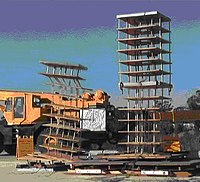
Photo from wikipedia
Abstract This study was aimed at highlighting the effect of loading frequency on the sand liquefaction response by performing cyclic triaxial tests in both stress-controlled and strain-controlled modes. For the… Click to show full abstract
Abstract This study was aimed at highlighting the effect of loading frequency on the sand liquefaction response by performing cyclic triaxial tests in both stress-controlled and strain-controlled modes. For the first case, dense (IDmat = 0.70) and medium-dense (IDmat = 0.55) sand specimens were subjected to alternative and non-alternative axial stresses; whilst dense (IDmat = 0.70) sand specimens were subjected to alternative axial strain over a wide range of loading frequencies in the second case. It was experimentally found that in the case of alternative loading for test specimens with IDmat = 0.70 in stress-controlled mode, the effect of the loading frequency was not notable for dry sand specimens. In contrast, the effect of the loading frequency was significant for saturated sand specimens in both the loading modes. This was because, upon shearing, transient deformation occurred with the presence of excess pore water pressure, during which the inertia force needed to be taken into account. In the axial direction, the inertia force opposing the external loading certainly increased the liquefaction resistance by suppressing the complete development of the sand liquefaction. As for non-alternative loading in stress-controlled mode for test specimens with IDmat = 0.55, the loading frequency played a vital role in pure extensional loading, which could also be logically attributed to the presence of the axial inertia force appearing in the large strain and transient deformation stages. However, the effect of the loading frequency on the compressive pattern was unclear due to the following two reasons: (i) the inertia force in the lateral direction appeared in the form of enhancing lateral confinement, thereby impeding the relative sliding; and (ii) during shearing, the rearrangement of the sand grains occurred in a more stable direction. These two aspects both provided beneficial contribution to sand liquefaction resistance, thereby preventing the occurrence of transient deformation. Under the circumstance, the sand specimens deformed only moderately, thereby eliminating the need to consider the role of the loading frequency.
Journal Title: Soil Dynamics and Earthquake Engineering
Year Published: 2021
Link to full text (if available)
Share on Social Media: Sign Up to like & get
recommendations!